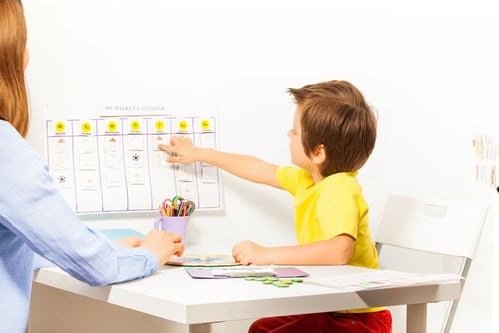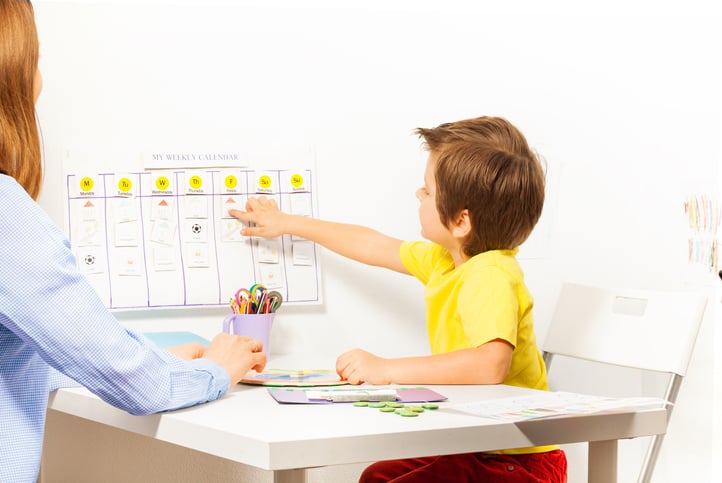Autism 101: 10 Tips for General Education Teachers
There is a common saying in special education when referring to our autistic learners - if you’ve met one autistic child; you’ve met one autistic child. Teachers need to remember that each child is unique and will have a distinctive combination of strengths, needs, and challenges that you, the general educator, can address through basic modifications and additions to your classroom.
What can general educators do to support autistic learners in the classroom?
1. Relationships above all else.
None of the strategies outlined below will be successful without a positive relationship between student and teacher. Getting to know your autistic student should begin by simply spending time together, ideally non-instructional time. Play with the student on the playground at recess. Eat lunch together. Engage with the student’s particular interest. Any time spent engaging in a reinforcing activity will help create a positive relationship that will assist later with gaining trust. Speaking with the resident expert of your student, parents, or caregivers can often provide additional insight into the student’s particular likes and dislikes that can be helpful when forging that initial relationship. When appropriate, asking what you as the educator can do to facilitate their success is an important exercise in not only relationship building but also self-advocacy skills for your student as well.

2. Children first.
Autistic children are children first and foremost. Consider the student’s age when determining expectations. For example, is it age-appropriate for a 3-year-old to sit and attend for 45 minutes? Likely not, so expecting this of your autistic student or any student is likely to result in difficulties. Treat your autistic student as you would any other child - support, guide, encourage, and celebrate successes! Keep in mind that children of all ages experience difficulties and setbacks. Monitor your thought process so you are not attributing all challenges to the student’s autism and remember that kids will be kids!
3. Be predictable.
Autistic students thrive in a structured and predictable environment. You can help create this type of environment in your classroom by posting a schedule for the day. Depending on the student, this schedule may be written or visual/photo-based. Create concrete routines in your classroom for transitions and ensure that you are practicing and reinforcing these routines often. When possible, provide warning of any scheduled changes like substitute teacher plans, assembly plans, field trips, or fire drills. Whenever unscheduled changes arise, coach your student through the change of plans and remind the student of their prior successes in navigating change. Using “First/Then” charts is a great way to provide a simple structure to an event. The more structured and predictable your typical day-to-day classroom routine is, the better your student will respond when there are changes to their schedule.

4. Keep it simple.
Use short sentences and simple language when providing instruction or direction and provide ample time for processing. Avoid repeating an instruction or demand without providing a wait time. Continuing to repeat demands while the student is processing is likely to cause frustration rather than understanding. Using as few words as possible when delivering instructions, particularly if the student is frustrated, is key. Students on the spectrum may also have difficulty with figurative or sarcastic language, as many are concrete thinkers. Monitor your word choice and provide explanations for any sarcasm, humor, or figurative language that your student may not comprehend. This in-the-moment coaching is pivotal to your student generalizing their skills.
5. Consider sensory needs.
Autistic students may experience sensory challenges, such as sensory-seeking behaviors like jumping and flapping, or sensory-avoiding behaviors such as the inability to tolerate noise. Sensory difficulties affect a student’s ability to participate in classroom activities such as attending to a speaker, filtering out auditory stimuli, and maintaining a state of behavioral equilibrium. Ensuring that the environment is not visually overstimulating through classroom decor can be helpful. Providing appropriate space during circle time, for example, or providing headphones or earbuds to wear during loud activities will allow your student to engage appropriately without being overwhelmed with sensory overload. Making use of a sensory builder sensory kit can be useful by having it nearby and using items from it when needed.
6. This or that?
Autistic students often struggle with self-advocacy and making choices. Allowing your student to make choices, even small choices such as using a pen or a pencil or deciding which 10 problems to solve, allows your student to practice self-advocacy and decision-making skills and, as a bonus, also allows you to avoid the dreaded power struggle. Choice-making can be easily integrated throughout the day. Keep in mind that all options offered should be acceptable and available. For example, if it is not an option to go outside due to rain, do not offer outside as a choice.
7. Be flexible.
Some students may prefer to write standing up. Other students may need to walk around the back of the classroom while they listen to read-aloud. Some students may need to wear headphones during independent work time. Other students may need to hold a fidget toy or sit at the small group table during seat work. Be willing to attempt new ideas or strategies as necessary and approach each day as a new day.

8. Consider communication needs.
Many autistic students struggle with expressive and/or receptive language. Some students may exhibit maladaptive behaviors in the classroom. It is important to remember that all behavior is an attempt at communicating a need. Assist your student in those moments by providing scaffolding so they can communicate their needs appropriately rather than through their behavior. Having visuals easily accessible as well as using basic communication boards can help provide students with multiple modes of communication.
9. Social skills.
Autistic students often desire to interact with others, however, they may lack the skills necessary to navigate social relationships. Students react differently to their social deficits. Some will avoid any interactions even though they desire the connection while others may engage in attention-seeking behaviors in an attempt to interact with others due to their lack of appropriate social skills. Creating a culture of inclusion within the general education classroom is paramount to social skills success. Providing students with a script or social story before a social situation is often helpful in reducing anxiety. A teacher might pull a student aside and let them know they are going to call on them first to pick their book character and provide a model or a scripted response. Identifying peers who may be appropriate and willing social skills models to pair with your autistic student is beneficial as well.
10. Positive reinforcement.
All students thrive on praise but for autistic students, verbal and physical praise are pivotal to their academic and behavioral success. Provide your student with specific verbal praise, such as “I love how you helped your friend pick up their crayons. You are such a great friend!” whenever possible. Reinforcing appropriate skills will help ensure that your student continues to demonstrate those skills. Allow your student to work towards a desired item or activity. This is a great time to pull in your student’s particular interests and have them work towards time to engage in their preferred activity. Provide your student with a concrete goal, such as “if you earn 5 stickers, you can earn time with the classroom pet” and continue to follow up and remind the student what they are working towards. Add visuals to enhance understanding as well.
Simple tweaks and adjustments to your daily teaching routines can spell comfort and success for your autistic students but also benefit all learners.
What strategies have you implemented in your inclusion classroom that have been successful for your autistic students?

Sarah Flockton
Sarah is a graduate of Texas State University with her Masters in Special Education and Applied Behavior Analysis. She has worked as a self-contained autism teacher, a district wide behavioral and autism specialist serving early childhood through adult transition students, and as a program manager for autism support services for a variety of public school districts in Texas.





